Avery House may refer to:

The Dyckman House, now the Dyckman Farmhouse Museum, is the oldest remaining farmhouse on Manhattan island, a vestige of New York City's rural past. The Dutch Colonial-style farmhouse was built by William Dyckman, c.1785, and was originally part of over 250 acres (100 ha) of farmland owned by the family. It is now located in a small park at the corner of Broadway and 204th Street in Inwood, Manhattan.

The George Cheever Farm is a historic farmstead at the corner of Nelson and Tolman Pond Roads in Harrisville, New Hampshire. This 1½-story wood-frame house was built in the early 1860s, and is a well-preserved example of a period farmhouse. It is architecturally distinctive because of a rear saltbox style addition, and its shed-roof dormers. The house was listed on the National Register of Historic Places in 1988.

Burpee Farm was a historic farmhouse on Burpee Road in Dublin, New Hampshire, United States. Probably built in 1793, it was a good example of 18th-century vernacular farmhouse architecture, and was one of the town's oldest buildings. It was listed on the National Register of Historic Places in 1983, and was destroyed by fire in 2013.
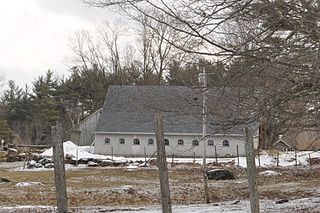
The Frost Farm is a historic farmstead on Korpi Road in Dublin, New Hampshire. It includes a farmhouse built in 1806 and subsequently enlarged, and a renovated 19th-century barn. The property is significant for its architecture, and for its ownership by both early settlers and later Finnish immigrants. A portion of the property was listed on the National Register of Historic Places in 1983.

The Joseph Gowing Farm is a historic farmhouse on Page Road in Dublin, New Hampshire. Built in 1908 as part of a gentleman's farm, it is a reconstruction of a late-18th century farmhouse, and a good example of Georgian Revival architecture. The house was listed on the National Register of Historic Places in 1983.

The Lawrence Farm is a historic farm at 9 Lawrence Road in Troy, New Hampshire. Established in the early 19th century, the property has been in continuous ownership by the same family since then. Its farmstead, including a c. 1806 farmhouse, exemplifies the changing trends in domestic agricultural practices of the 19th and 20th centuries. The farm was listed on the National Register of Historic Places in 2000.
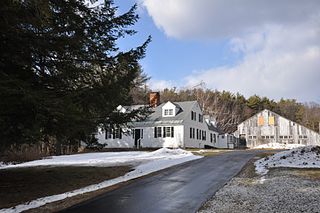
The Micajah Martin House is a historic house on Old Peterborough Road in Dublin, New Hampshire. Built about 1802, it is a well-preserved local example of an early Cape-style farmhouse. The house was listed on the National Register of Historic Places in 1983.

The Moore Farm and Twitchell Mill Site is a historic property on Page Road in Dublin, New Hampshire. The 6.8-acre (2.8 ha) property includes an early 19th-century farmhouse, as well as the remnants of one of Dublin's earliest industrial sites. It lies just south of a bend in Page Road in southern Dublin, where Stanley Brook runs east-west along the south side of the road. In c. 1768 Samuel Twitchell, Dublin's second settler, built a sawmill that used Stanley Brook as its power source. This mill was the second established in what is now Dublin, after that of Eli Morse. It was used until the mid-19th century, and now only its foundations remain. The farmhouse of Samuel Moore was built in a glen on the south side of the brook c. 1812, and was a vernacular Cape style farmhouse. The farm was purchased in 1935 by William and Katherine Mitchell Jackson, and the house was moved about 100 yards (91 m) to the top of a rise where it has commanding views of Mount Monadnock. The house was restored and enlarged under the guidance of architects Bradley & Church and again renovated in 1951. The farm complex includes a barn that is contemporaneous to the house, and a caretaker's cottage that is a 1952 reconstruction of an earlier one destroyed by fire.
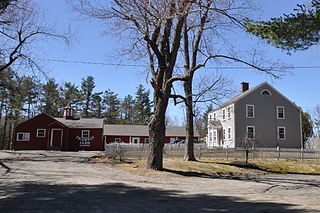
The Asa Morse Farm, also known as the Friendly Farm, is a historic farmstead on New Hampshire Route 101 in Dublin, New Hampshire. The main farmhouse, built in 1926 on the foundations of an early 19th-century house, is a good example of Colonial Revival architecture, built during Dublin's heyday as a summer retreat. The farmstead was listed on the National Register of Historic Places in 1983.

The Solomon Piper Farm is a historic farmhouse at 227 Valley Road in Dublin, New Hampshire. Built about 1794, it is a good example of an early Cape style farmstead. The house was listed on the National Register of Historic Places in 1983. The home of Solomon Piper's son, the Rufus Piper Homestead, also still stands and is also listed on the National Register of Historic Places.
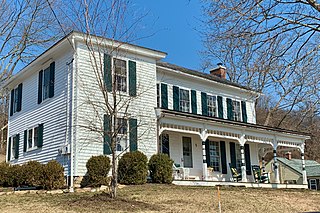
Amsterdam is an unincorporated community located within Holland Township in Hunterdon County, in the U.S. state of New Jersey. Located on the southern flank of the Musconetcong Mountain, the area was settled in the first half of the 18th century. It was later named after Amsterdam, Netherlands. The Amsterdam Historic District, encompassing the community, was listed on the state and national registers of historic places in 1995.

The William Green House is a historic brick farmhouse in Ewing Township of Mercer County, New Jersey, United States. It was added to the National Register of Historic Places on December 4, 1973, for its significance in agriculture and architecture.

Top Acres Farm, known historically as the Fletcher–Fullerton Farm, is a farm property at 1390 Fletcher Schoolhouse Road in Woodstock, Vermont. Developed as a farm in the early 19th century, it was in continuous agricultural use by just two families for nearly two centuries. It was listed on the National Register of Historic Places in 2004.
The Dan Johnson Farmstead is a historic farm property on United States Route 2 in Williston, Vermont. It was first developed in 1787 by Dan Johnson, one of Williston's first settlers, and has remained in his family since that time. The property includes three 19th-century houses and a large barn complex, as well as more than 200 acres (81 ha) of land crossed by US 2 and Interstate 89. It was listed on the National Register of Historic Places in 1993.

The Anthony–Corwin Farm is a historic farmhouse located at 244 West Mill Road near Long Valley in Washington Township, Morris County, New Jersey. It was added to the National Register of Historic Places on May 1, 1992, for its significance in architecture. The 11.5-acre (4.7 ha) farm overlooks the valley formed by the South Branch Raritan River. The farmhouse is part of the Stone Houses and Outbuildings in Washington Township Multiple Property Submission (MPS).

The J. K. Apgar Farmhouse is a historic stone house located at the intersection of County Route 512 and Guinea Hollow Road in the borough of Califon in Hunterdon County, New Jersey. It was added to the National Register of Historic Places on November 1, 1979, for its significance in architecture.

The Kline Farmhouse, also known as Cold Spring Cottage, is located on a 12-acre (4.9 ha) farm along County Route 517, north of Oldwick in Tewksbury Township of Hunterdon County, New Jersey. Built by Jacob Kline in the 1790s, it was added to the National Register of Historic Places on July 11, 1984, for its significance in agriculture, architecture and settlement. Also known as the Beavers House, it was previously documented by the Historic American Buildings Survey in 1966. It was later listed as a contributing property of the Oldwick Historic District in 1988.

The Davenport–Demarest House is a historic farmhouse located at 140 Changebridge Road in the township of Montville in Morris County, New Jersey. The oldest section was built c. 1720–1730. The farmhouse was documented by the Historic American Buildings Survey in 1938. It was added to the National Register of Historic Places on January 17, 1992, for its significance in architecture. It was listed as part of the Dutch Stone Houses in Montville, New Jersey Multiple Property Submission (MPS).
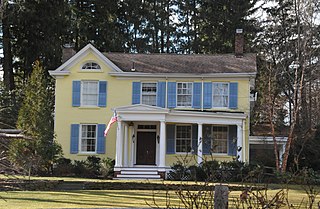
The James Van Duyne Farmhouse is a historic building located at 32 Waughaw Road in the Towaco section of the township of Montville in Morris County, New Jersey. The oldest section of the farmhouse was built in 1758. It was added to the National Register of Historic Places on April 15, 1982, for its significance in exploration/settlement and politics/government.




















